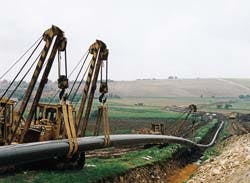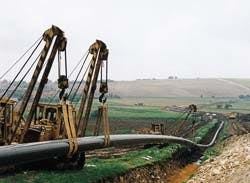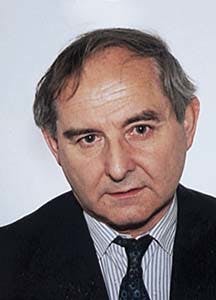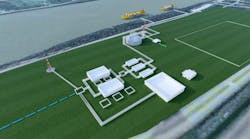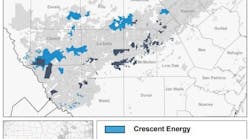Bretislav Karsek, Miroslav Cibulka
MERO CR A.S. Kralupy nad Vltavou
Czech Republic
The MERO-IKL pipeline is another source of crude oil forCzech refineries (fig. 1).
- The firing line along MERO-IKL construction (Fig. 3 [15,244 bytes]).
- Fiber optic cables were installed over the line pipe (Fig. 4 [17,725 bytes]).
- Stress testing along the entire line ensures its integrity (Fig. 5 [10,954 bytes]).
Since August 1995, the company has started up a 4.8 million bbl crude-oil storage terminal (OGJ, Feb. 3, 1997, p. 54), installed a 345-km crude-oil pipeline linked to the West European Trans Alpine (TAL) pipeline, and plans ma jor modifications of the Czech section of the pipeline that supplies the country from Russia via Slovakia (Fig. 2).[ 33,121 bytes]
In the past, Czech and Slovak refineries fully depended on Russian crude oil supplied by the southern branch of the Druzhba I pipeline. The only exception occurred for a few months in 1992 when the Adria pipeline brought in supplies from a Croatian port terminal at Omishail.
Total crude-oil consumption in the former Czechoslovakia on the eve of the end of communist rule had reached 17 million tons/year (340,000 b/d).
After November 1989 and the end of communist rule, a new strategy of energy-supply policy was set up by the Czech government to secure alternate crude-oil supply independent of Russia.
In January 1993, the Federal Republic of Czechoslovakia split into two fully independent states, the Czech Republic and Slovakia, each adopting its own energy-supply strategy.
The Czech Republic studied several alternatives, such as an Adria pipeline extension and connection either on North Germany or TAL pipeline systems. It was finally decided to construct a new pipeline linking the West European TAL system to bring crude oil from the Italian port terminal of Trieste.
Construction of the new 28-in. pipeline, known as the MERO-IKL, from Ingolstadt area to Kralupy nad Vltavou crude-oil terminal, was completed in late 1996.
Czechs won necessary crude-oil supply independence, and three Czech refineries in Litvinov, Kralupy nad Vltavou, and Pardubice can now be supplied either from the east by Russian crudes or from the west by any crude grade. Slovakia continues to depend on existing eastern sources of crude oil.
MERO CR operates the Czech crude-oil pipelines as well as the Kralupy crude-oil terminal. With installed pumping fully operating, each pipeline, MERO IKL and Druzhba, would have a capacity of 200,000 b/d. Total Czech refining capacity, on the other hand, is slightly more than 187,000 b/d (OGJ, Dec. 23, 1996, p. 49).
Former structure
Druzhba pipeline is an expression which applies to a crude-oil pipeline network supplying Russian crude oil to such former Comecon countries as Poland, East Germany by its northern branch, and Czechoslovakia and Hungary by its southern branch.
The Czech section of Druzhba (Fig. 2) consists of three pumping stations and 580 km of pipelines of different sizes: 424 km of 20 in., 37 km of 28 in., 87 km of 12 in., and 32 km of 8 in.
The major part of the system was built and put into operation in the 1960s and early 1970s. With increasing demand of crude-oil imports, its capacity has been gradually expanded by adding new pumping stations and the looping of some sections (Fig. 2).
Sections of 28 in. (37 km) and 20 in. (68 km) parallel to the main 20-in. pipeline were built in the late 1970s to cover extended throughput requirements. The pipelines are equipped with more than 100 closing valves (mainly gate type), most of which are hand operated.
Line pipe supplied for the construction is of different origin and of different methods of manufacturing: seamless welds (Czech tube manufacturer in Chomutov) and spiral welds (Slovak manufacturer in Kosice).
Line pipe material Grade X-52 or equivalent has an elasticity modulus of 2.1 x 107 Newtons/mm (12 x 107 lb/in.). Pipe-wall thicknesses differ from 8 to 12 mm (0.320-0.480 in.) depending on the pipeline's hydraulic profile.
The pipelines are externally bitumen coated and protected by an integrated system of cathodic protection. Maximum operating pressure is 6.4 MPa (928.9 psig).
Pumping stations (PS) are located along the pipeline to produce optimum pressure profile and energy consumption at desired crude-oil throughput. They are equipped with three to four horizontal NG 300 centrifugal pumps (Pumpenwerke Halle IS, Germany) provided with mechanical Crane seals with flow capacity = 1,600 cu m/hr, NPSH = 260 m, and power = 1,250 kw.
Each pumping station is equipped with pig receiving and launching chambers. PS 1 near the Slovak-Czech border was equipped in 1995 with a new flowmeter station consisting of two parallel Fisher-Rosemount (Germany) flowmeters working on Coriolis principle, automatic sampling skid from Jiscoot (U.K.), and pressure and temperature indicator and pressure-relief system from Grove (Italy).
Operation of the station is controlled by an autonomous advanced control system, which will be incorporated into an integrated control system as part of the modernization project of the Druzhba pipeline.
Present capacity of the pipeline, in which pumps are not fully utilized, is 180,000 b/d.
Repairs; modernization
The first detailed pipeline inspection by means of an intelligent pig working on ultrasonic principle was carried out 1993-1996.
It found 900 defects along the entire Czech section of the pipeline: 0.8-1.2 defects/km. The density of the defects varied from section to section and was partly related to the type of pipe used in the respective section.
The defects have been classified into five levels of importance with respect to potential danger, and appropriate priorities for repair have been defined.
In one section, 38% of the defects originated in the pipe manufacturing; 88% in the other section. Most were laminations on seamless or spiral-welded pipes. Only one defect was caused by external corrosion as a result of defective coating, but it was not serious.
Defects have not caused any pipe section to fail prescribed piping pressure test and mechanical strength requirements; section cut outs were therefore unnecessary.
Repairs were made by pressure-resistant steel sleeves filled with an epoxy-glass ballotins composite. ("Ballotins" are small glass balls used in epoxy composites as filler and to improve mechanical properties.)
The technology has been successfully applied for more than 10 years in most Czech and Slovak gas, crude oil, and product pipeline repairs.
The objective of the Druzhba pipeline upgrading project is to improve the safety and reliability of operation in compliance with new requirements of environmental protection principles.
Thus, MERO CR will be able to start a program of ISO 14000 implementation and certification.
The calculated capacity of the pipeline after modernization will be 140,000-150,000 b/d with pipeline safety factor 1.7-2.04. This capacity, although less than current levels, will reflect the improved safety and economy of the line's operation.
The modernization project includes the following:
- Reconstruction of all valve stations by replacing existing, mainly hand-operated gate valves with remotely operated ball valves. Double block-and-bleed valves (64 barg nominal; 928 psig) suitable for differential pressure bleed test with closing time 180-200 sec will be installed.
The valves will be installed in concrete pits. The valves' stations equipped with a field instrumentation will be integrated into a new control and communication system. - Installation of a new control and communication system. The supervisory control and data-acquisition (scada) system will consist of an autonomous control system for each pumping station and a supervisory control system in the Nelahozeves crude-oil tank terminal (OGJ, Feb. 3, 1997, p. 54).
The following automated programs will be part of the control system: remote and local control; standard start-up and shutdown operation; throughput adjustment program; piping rerouting to end stations; pipeline operation planning system; mass balancing, loss control; pig tracking; leak detection and localization (dynamic model); and emergency shutdown (ESD) system.
The communication digital system using optic cable will provide the following functions: operating data transmission; cathodic-protection system operation monitoring; telefax information transmission; remote control data and instructions transmission; phone communication (redundant to optic cable); communication interface between operating company and its partners, such as refineries, to transfer selective data and information.
- Refurbishment of some process facilities, such as end stations; installation of flowmeters, pressure-relief elements, and sampling skids; and slop-tank modernization.
- Upgrading some auxiliary facilities, such as fire protection and fire-fighting systems of pumping stations, water-treatment systems, and security systems.
MERO IKL pipeline
MERO IKL pipeline is a crude-oil pipeline connecting the TransAlpine (TAL) pipeline system with the Druzhba pipeline in Czech Republic.
The linking point to TAL is at Vohburg, Germany, next to the RVI refinery (Raffineriegesellschaft-Voh burg/Ingolstadt; OGJ, Dec. 23, 1996, p. 65). It consists of a receipt station, intermediate storage tanks, and a pumping station to feed the MERO IKL pipeline. These facilities and MERO IKL pipeline on German territory are owned and operated by MERO CR's German subsidiary MERO Pipeline GmbH, Vohburg.
Construction
The MERO IKL design has been provided by German and Czech engineering companies ILF Munich and Chemoprojekt/Litvinov.
ILF supplied a basic design of the entire system, detailed design, procurement services, project management, construction supervision, precommissioning, commissioning, and start-up assistance for the section located on German territory. Chemoprojekt provided detailed design for the Czech section and cathodic-protection design of the entire pipeline.
Major contractors participating on the pipeline construction were German companies Südrohrbau A.G./
Mannesmann and Streicher/Riepl, on German territory, and Czech companies Vodni stavby Prague, IPS Prague, Plynostav Pardubice, and CKD Prague on Czech territory (Figs. 2-6).
Ultrasonic and radiographic weld-quality control of the pipeline was provided by an independent international inspection organization, Röntgen Technischer Dienst-RTD Quality Services.
Tanks in Vohburg were supplied and constructed by Preussag-Noell, Germany. The control and communication system was supplied by ABB Energy and ABB/Siemens, Germany.
The polyethylene insulated pipe in lengths 16-18 m were delivered by Europipe, Germany, for the German section and by Preussag Hannover, Germany, for the Czech section of the pipeline. Flow Control Technology, of French Groupe Genoyer, Vitrolle, France, supplied the ball valves.
The MERO IKL system has been divided into several sections. Construction started in different terms between April and December 1994 with the common objective of beginning its operation in January 1996.
That task has been fulfilled. The capacity test of the pipeline was successfully carried out in June 1996. The pipeline was commissioned and has been in commercial operations since yearend 1996.
Technical elements
Total tank-storage capacity in Vohburg station is 1.2 million bbl, consisting of three mixing tanks of 240,000 bbl each and one tank of 480,000 bbl. Tank design is similar to that of MERO CR Nelahozeves tank terminal.1
The tanks are constructed on the principle of a double-bottom (vacuum leak-detection system) and double-deck floating roof equipped with a double-rim seal. The tanks' diameters are 52 and 73 m, respectively; height is 20 m.
The pump station consists of three main and three booster centrifugal horizontal pumps (Ingersoll, Germany) with design operating capacity of 755 cu m/hr each so that the pumping capacity into MERO IKL pipeline is 1,510 cu m/hr, equivalent to 200,000 b/d when operating two pumps in parallel.
The pumping station outlet pressure is 6.5 MPa (943.4 psig) max. Of the MERO IKL pipeline's 345-km length, 170 km is located on Czech and 175 km on German territory.
Table 1 [ 12,974 bytes] presents the pipeline's major characteristics.
With such a project of international importance so carefully watched by Czech and German governments and state authorities, great attention was paid to making the pipeline's operation environmentally clean and safe.
Technical aspects of the project fully respected Czech and German norms and standards as well as all requirements of the respective state authorities and professional institutions. Following are the most important provisions:
- Pipe high-tech quality (steel spec, insulation), pipeline welds radiographic and ultrasonic 100% testing
- Pipeline-coating spark test (Pearson)
- Pipeline stress-testing before the start-up operation (Fig. 7), which has only recently been introduced in the Czech Republic in new oil and gas pipelines
- Cathodic-protection system
- Special protective measures in water (82), road (14), and railway (23) crossings and other environmentally sensitive areas. These measures include groundwater- monitoring systems, pipe-closing elements on both sides of each crossing, and cased crossings.
- State-of-the-art automatic control system of the pipeline including all valve stations
- Redundant optical cable and phone communication system
- Multiple leak-detection systems (dynamic pressure wave, flow rate comparison, tank-level comparison, leak- detection pig, pressure tests)
- Pipeline baseline inspection by an intelligent pig
- Systematic pipeline inspections during operation
- Emergency planning system specially developed for MERO IKL pipeline.
Controls
The scada on the MERO IKL pipeline was designed to secure high reliability and security standards set up in Western Europe for pipelines in recent years. Therefore, the entire transmission line, from programmable logic controller (PLC) to a control system, is redundant, and an additional ESD system has been installed.
The MERO IKL pipeline control system is based on decentralized and distributed control functions with the main control center located in the tank and pumping station at Vohburg, Germany, near Ingolstadt.
Remote terminal units (RTUs) are located on valve stations along the pipeline. PLCs (ABB RTU 510) are configured for operation either remotely from the control center or locally from a personal computer (PC) workstation.
RTUs are located both at the Vohburg tank and pumping station and at the Nelahozeves terminal. A PLC (ABB Procontic T 200) in redundant structure is used with a "hot-standby" mode in case of unbalanced operation. These elements can be operated remotely or locally.
The supervisory computer control system at Vohburg consists of two redundant operator workplaces based on DEC Alpha AXP Workstation and operates under Digital Unix operation system. Two servers with RP 570 protocol are used to link process data.
The monitoring system is formed by a DEC Alpha AXP Workstation and is located at the Nelahozeves terminal control center to monitor in real-time actions made by Vohburg control center in real time.
The pipeline and the Voh burg and Nelahozeves RTUs are configured to collect, evaluate, and generate analog, digital, and pulse inputs in compliance with the software module. Visualization of man-machine interface for nonstandard pipeline conditions, such as maintenance and local control, is possible as well.
The supervisory control system provides the following:
- Basic control-scada, for example
- Advanced control-leak detection and localization, for example, along with batch tracking, pipeline dynamic modeling, and simulation alarm handling; pipeline-pressure-profile monitoring, whose redundant calculations are based on physical model of flow mechanics; alarm handling; operations-data archiving; and Vohburg tank-farm management; mass balancing; and invoicing based on SQL data bank.
The ESD system, independent to the control system, fulfills the latest environmental-protection requirements of the state authorities and respective norms and standards.
Such a system, corresponding to safety reliability standard, Class 5, has been designed to shut down pipeline operations automatically in case operating conditions become unsafe: pump failure, excessive pressure, or sudden closing of any pipeline valve.
In such a case, the pipeline is shut down sequentially by an ESD system provided by Paul Hildebrandt GmbH & Co. KG Industrie Automatisierung, Bruhl, Germany.
Communications
The system on MERO IKL pipeline providing communications between individual ESDs and RTUs consists of a 12 fiber optic cable, a transmission system (PCM 30) with transmission capacity up to 32 channels, each having 64 kb/sec, and a monitoring system operating in real time at Nelahozeves terminal.
The communication system operates with ABB RP 570 protocol based on IEC 870 5.1 FT 1.2 Standard. The process data bank is upgraded within 1 sec maximum.
Data transmission from individual RTUs on German and Czech territory is provided by channels of the tranmsission system in parallel so that the RTUs are divided into three groups, each using a separate channel.
Redundant communication is secured by means of modems through a public phone network in case of optic cable failure.
A stripe wireless transmission system is installed on Czech territory for communications between Nelahozeves terminal control center and pipeline inspection personnel.
References
- Sin gl, A., Volf, V., Feizlmayr, A., and Kohler, A., "Die Mitteleurop?ische Roh?lleitung (MERO), Erd?l, Erdgas, Kohle, 111. Jahrg., 1995, Nr. 7/8, pp. 322-24.
- Fleischbauer, J., Linke, A., Sch?fer, K., and Wege, J., "Das Steuerungssystem der Miffeleuropaischen Roholpipeline (MERO)," Erd?l, Erdgas, Kohle, 113. Jahrg., Nr. 2, pp. 71-73.
The Authors
Bretislav Karasek is the board vice-chairman and technical director of the Czech oil-transportation company, MERO CR. He is in charge of technical development projects fron design to start-up of operation. Before joining MERO CR in 1993, he was technical director at Kaucuk Kralupy, a large Czech refining and petrochemical company. Karasek holds a master degree in chemcial engineering and macromolecular chemistry from Chemical & Technical University of Prague. He has been awarded a title of top specialist in chemical engineering from the Ministry of Industry.
Miroslav Cibulka is a specialist in instrumentation and advanced control systems at MERO CR. He worked for Kaucuk Kralupy more than 30 years before joining MERO CR. Cibulka holds a masters degree in electrical engineering from the Technical University of Prague.
Copyright 1997 Oil & Gas Journal. All Rights Reserved.
